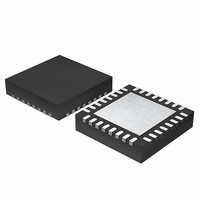EFM32G200F64 Energy Micro, EFM32G200F64 Datasheet - Page 147

EFM32G200F64
Manufacturer Part Number
EFM32G200F64
Description
MCU 32BIT 64KB FLASH 32-QFN
Manufacturer
Energy Micro
Series
Geckor
Datasheets
1.EFM32G200F16.pdf
(63 pages)
2.EFM32G200F16.pdf
(10 pages)
3.EFM32G200F16.pdf
(463 pages)
4.EFM32G200F16.pdf
(136 pages)
Specifications of EFM32G200F64
Core Processor
ARM® Cortex-M3™
Core Size
32-Bit
Speed
32MHz
Connectivity
EBI/EMI, I²C, IrDA, SmartCard, SPI, UART/USART
Peripherals
Brown-out Detect/Reset, DMA, POR, PWM, WDT
Number Of I /o
24
Program Memory Size
64KB (64K x 8)
Program Memory Type
FLASH
Ram Size
16K x 8
Voltage - Supply (vcc/vdd)
1.8 V ~ 3.8 V
Data Converters
A/D 4x12b, D/A 1x12b
Oscillator Type
External
Operating Temperature
-40°C ~ 85°C
Package / Case
32-VQFN Exposed Pad
Processor Series
EFM32G200
Core
ARM Cortex-M3
Data Bus Width
32 bit
Data Ram Size
16 KB
Interface Type
I2C, UART
Maximum Clock Frequency
32 MHz
Number Of Programmable I/os
24
Number Of Timers
2
Operating Supply Voltage
1.8 V to 3.8 V
Maximum Operating Temperature
+ 85 C
Mounting Style
SMD/SMT
Minimum Operating Temperature
- 40 C
Lead Free Status / RoHS Status
Lead free / RoHS Compliant
Eeprom Size
-
Lead Free Status / Rohs Status
Details
Available stocks
Company
Part Number
Manufacturer
Quantity
Price
- EFM32G200F16 PDF datasheet
- EFM32G200F16 PDF datasheet #2
- EFM32G200F16 PDF datasheet #3
- EFM32G200F16 PDF datasheet #4
- Current page: 147 of 463
- Download datasheet (8Mb)
15.3.4 Clock Generation
15.3.5 Arbitration
2010-09-06 - d0001_Rev1.00
I2Cn_CTRL must be reset. This should be done regardless whether the slave is going to be re-enabled
or not.
The SCL clock signal generated by the I
The clock is generated as a division of the peripheral clock, and is given by Equation 15.2 (p. 147) :
I
N
signal respectively. The worst case low and high periods of the signal are:
I
The values of N
controlled by CLHR in the I2Cn_CTRL register. The available modes are summarized in Table 15.2 (p.
147) along with the highest I
violating the timing specifications of the I
allowed rise and fall times of SDA and SCL into account. Higher frequencies may be achieved in
practice. The 3 extra cycles are synchronization, and must be taken into consideration when DIV in the
I2Cn_CLKDIV register has a low value.
Note
Table 15.2. I
Arbitration is enabled by default, but can be disabled by setting the ARBDIS bit in I2Cn_CTRL. When
arbitration is enabled, the value on SDA is sensed after each time the I
its value. If the sensed value is different than the value the I
a simultaneous transmission by another device, and the I
Whenever arbitration is lost, the ARBLOST interrupt flag in I2Cn_IF is set, any lines held are released,
and the I
another master may be trying to address it. The master therefore receives the rest of the address, and
if the address matches the slave address of the master, the master goes into either slave transmitter
or slave receiver mode.
Note
2
2
Mode
STANDARD
ASYMMETRIC
FAST
C Maximum Transmission Rate
low
C High and Low Cycles Equations
and N
2
C device goes idle. If an I
DIV must be 1 or higher when slave is enabled.
Arbitration can be lost both when operating as a master and when operating as a slave.
high
2
C Clock Modes
specify the number of prescaled clock cycles in the low and high periods of the clock
low
CLHR
0
1
2
and N
f
SCL
high
= f
T
T
high
low
HFPERCLK
and thus the ratio between the high and low parts of the clock signal is
2
C-bus frequencies in the given modes that can be achieved without
= (N
= (N
N
4:4
6:3
11:6
2
low
high
low
C master loses arbitration during the transmission of an address,
/(((N
: N
x (DIV + 1)+ 3)/f
x (DIV + 1) + 3)/f
2
C master determines maximum transmission rate on the bus.
high
2
C-bus. The frequencies are calculated taking the maximum
low
+ N
...the world's most energy friendly microcontrollers
147
high
Sm max
frequency
93 kHz
75 kHz
79 kHz
) x (DIV + 1)) + 4)
HFPERCLK
HFPERCLK
2
C module has lost arbitration.
2
C module tried to output, it is interpreted as
Fm max
frequency
313 kHz
392 kHz
383 kHz
2
C module attempts to change
www.energymicro.com
Fm+ max
frequency
806 kHz
980 kHz
987 kHz
(15.2)
(15.3)
Related parts for EFM32G200F64
Image
Part Number
Description
Manufacturer
Datasheet
Request
R

Part Number:
Description:
KIT STARTER EFM32 GECKO
Manufacturer:
Energy Micro
Datasheet:

Part Number:
Description:
KIT DEV EFM32 GECKO LCD SUPPORT
Manufacturer:
Energy Micro
Datasheet:

Part Number:
Description:
BOARD PROTOTYPING FOR EFM32
Manufacturer:
Energy Micro
Datasheet:

Part Number:
Description:
KIT DEVELOPMENT EFM32 GECKO
Manufacturer:
Energy Micro
Datasheet:

Part Number:
Description:
MCU, MPU & DSP Development Tools TG840 Sample Kit
Manufacturer:
Energy Micro
Datasheet:

Part Number:
Description:
MCU, MPU & DSP Development Tools TG Starter Kit
Manufacturer:
Energy Micro
Datasheet:

Part Number:
Description:
MCU, MPU & DSP Development Tools TG108 Sample Kit
Manufacturer:
Energy Micro

Part Number:
Description:
MCU, MPU & DSP Development Tools TG210 Sample Kit
Manufacturer:
Energy Micro
Datasheet:

Part Number:
Description:
MCU, MPU & DSP Development Tools TG822 Sample Kit
Manufacturer:
Energy Micro
Datasheet:

Part Number:
Description:
MCU, MPU & DSP Development Tools TG230 Sample Kit
Manufacturer:
Energy Micro

Part Number:
Description:
SAMPLE KIT (SMALL BOX - CONTAINING 2 DEVICES)
Manufacturer:
Energy Micro

Part Number:
Description:
SAMPLE KIT (SMALL BOX - CONTAINING 2 DEVICES)
Manufacturer:
Energy Micro











